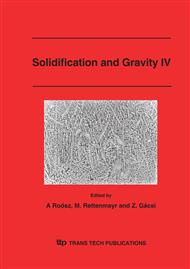p.251
p.257
p.263
p.269
p.275
p.281
p.287
p.295
p.301
Liquid-Metal Foams – Feasible In Situ Experiments under Low Gravity
Abstract:
Metal foams are quite a challenge to materials scientists due to their difficult manufacturing. In all processes the foam develops in the liquid or semiliquid state. Liquid-metal foams are complex fluids which contain liquid metals, solid particles and gas bubbles at the same time. An X-ray transparent furnace was developed to monitor liquid metal foam evolution. Aluminium foams - similar to the commercial Metcomb foams - were produced by feeding argon or air gas bubbles into an aluminium composite melt. The foam evolution was observed in-situ by X-ray radioscopy under normal gravity. Drainage and rupture were evaluated during the 5 min foam decay and 2 min solidification. Argon blown foams showed significant drainage and cell wall rupture during the first 20 s of foam decay. Air blown foams were stable and neither drainage nor rupture occurred. We demonstrated the feasibility of experiments during parabolic flight or drop tower campaigns. However, the development of a foam generator for low gravity is needed.
Info:
Periodical:
Pages:
275-280
Citation:
Online since:
March 2006
Authors:
Keywords:
Price:
Сopyright:
© 2006 Trans Tech Publications Ltd. All Rights Reserved
Share:
Citation:


